SanDisk Extreme Pro SSD (240GB, 480GB & 960GB) Review: The Fastest Just Got Faster
by Kristian Vättö on June 16, 2014 4:00 PM EST- Posted in
- Storage
- SSDs
- SanDisk
- Extreme Pro
Random Read/Write Speed
The four corners of SSD performance are as follows: random read, random write, sequential read and sequential write speed. Random accesses are generally small in size, while sequential accesses tend to be larger and thus we have the four Iometer tests we use in all of our reviews.
Our first test writes 4KB in a completely random pattern over an 8GB space of the drive to simulate the sort of random access that you'd see on an OS drive (even this is more stressful than a normal desktop user would see). We perform three concurrent IOs and run the test for 3 minutes. The results reported are in average MB/s over the entire time.
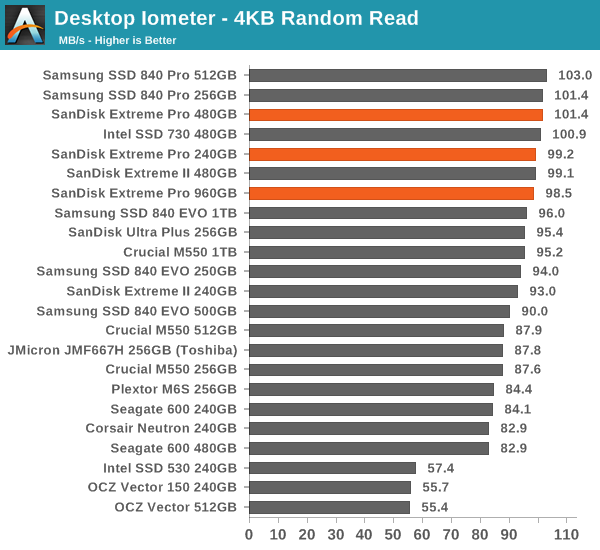
The random read performance is great, which was expected when coming from the Extreme II.
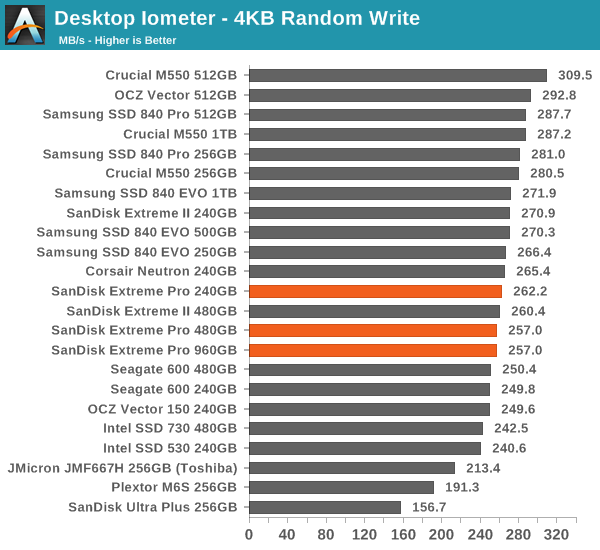

Random write performance, on the other hand, is only mediocre, although it's consistency that matters and not necessarily the peak performance. It seems that drives with high consistency do not have as good peak performance because the Extreme Pro, Vector 150 and SSD 730 are in the middle, whereas the 840 EVO and M550 lead the pack despite their relatively poor IO consistency. I would take consistency over ~10% better peak performance, though.
Sequential Read/Write Speed
To measure sequential performance we run a 1 minute long 128KB sequential test over the entire span of the drive at a queue depth of 1. The results reported are in average MB/s over the entire test length.
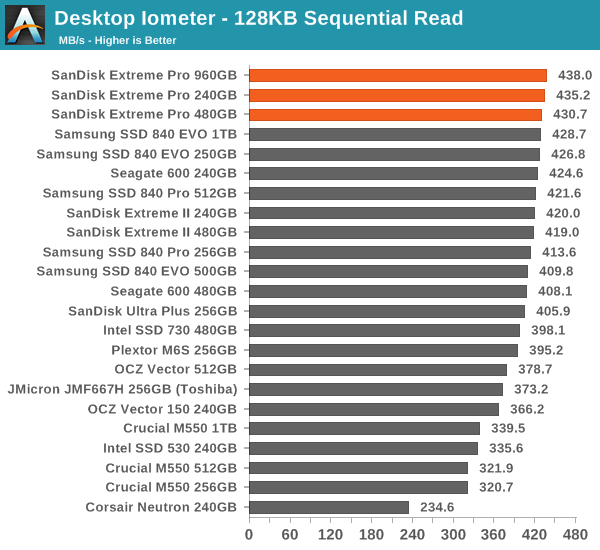
Sequential performance is definitely good. I think the high read speed is one of the reasons why the Extreme Pro did so well in the 2013 Storage Bench because both the SSD 730 and Vector 150 are noticeably slower.
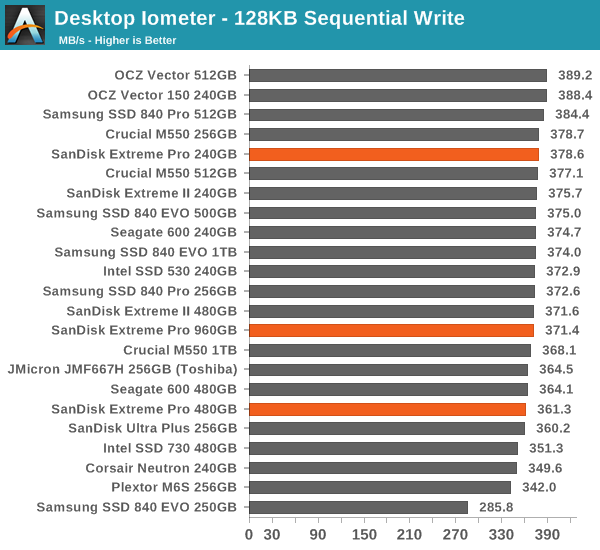
AS-SSD Incompressible Sequential Read/Write Performance
The AS-SSD sequential benchmark uses incompressible data for all of its transfers. The result is a pretty big reduction in sequential write speed on SandForce based controllers.
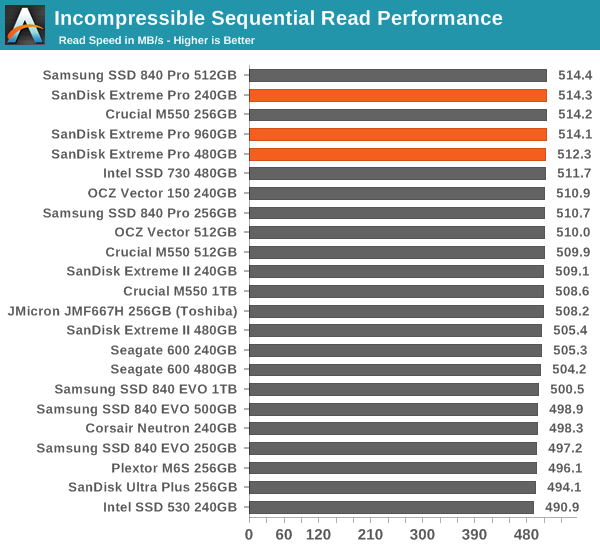
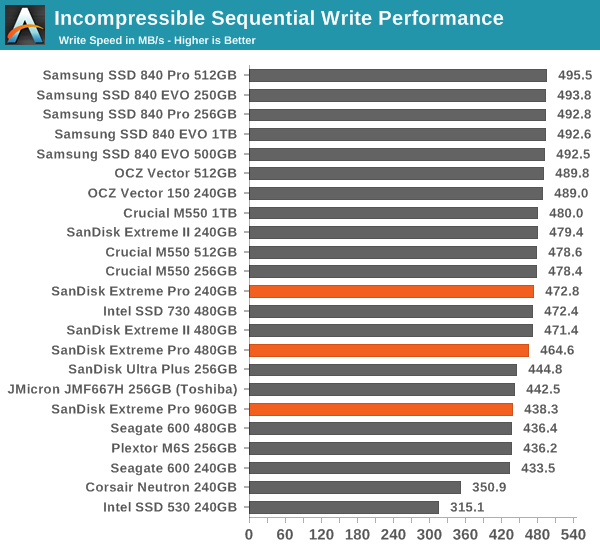










85 Comments
View All Comments
LtGoonRush - Monday, June 16, 2014 - link
The only improvements are idle power consumption and support for Low-Power DDR3, and this isn't really a mobile-targeted drive.Oyster - Monday, June 16, 2014 - link
10 years warranty. Love it. L.O.V.E. I.T. Thank you, SanDisk, for setting this trend. I'll surely wait, but I think this is exactly what I need for my next build.10 years... OMFG! Drool!
tential - Monday, June 16, 2014 - link
It's a great warranty but I think ssds potential failure points are less than an hdd. (my speculation).When I saw that though it definitely peaked my interest. Would have purchased this drive if it had been an option as that warranty would definitely make me feel better as I hold onto my hardware for a long time.
MrSpadge - Tuesday, June 17, 2014 - link
I'd still choose the MX100 over this any day. It's not like these drives are falling apart everywhere. And if you save the price difference between these drives you could use it to buy something significantly better in a few years, should the MX100 have failed by then (I wouldn't expect it to).nathanddrews - Tuesday, June 17, 2014 - link
This is pretty awesome:http://techreport.com/review/26523/the-ssd-enduran...
havefunbob - Tuesday, June 17, 2014 - link
that is really good testbinarycrusader - Monday, June 16, 2014 - link
How exactly is this a no compromise drive when it doesn't offer encryption and it doesn't offer capaciyor-based power loss protection? Data integrity and security seem like pretty big compromises. Or is the SLC buffer seen as a sufficient substitute for a capacitor-based solution?BillyONeal - Monday, June 16, 2014 - link
It is a no compromise drive for the market it targets -- the consumer market. Few / no consumer-targeted drives have capacitors; pretty much all such drives are targeting the server market, such as Intel's SSD DC3700. Very few consumer drives offer TCG Opal, but some do, e.g. Samsung's 840 EVO.binarycrusader - Monday, June 16, 2014 - link
The author specifically mentioned disappointment at the lack of encryption, and the author, unlike you specifically used the phrase "only no compromise high-end SSD in the market" while simultaneously declaring Intel's 730 SSD, OCZ's Vector 150, and Samsung 840 Pro as being in that same "high-end" market. So it seemed rightfully bizarre to simultaneously proclaim it as a "no compromises" drive given the other drives the author also compared it to that are supposedly in the same market.Also, while you're right that few consumer-targeted drives have capacitors, the Crucial M500 does. And honestly, capacitors don't cost that much, but it's no wonder Intel's happy to let all of the other manufacturers fight over "razor-thin" margins.
Kristian Vättö - Tuesday, June 17, 2014 - link
Because the Extreme Pro is the only high-end SSD without the compromises that the three other SSDs have. Intel SSD 730 and OCZ Vector 150 don't support any form of low-power states and are thus not suitable for laptops. The 840 Pro, on the other hand, lacks IO consistency. All three drives are in the same high-end performance market, thus I'm comparing the Extreme Pro with them.Crucial's drives have capacitors that provide power loss protection but they are the only drives along with Intel's SSD 730. However, you can get away without capacitors if the firmware is designed not to rely too much on the DRAM cache. I would certainly like to see OEMs use capacitors more in consumer-grade drives but on the other hand, I'm not sure if I consider it to be that big of a deal. We don't have a proper way to test power losses, so I don't want to give too much value to a feature that may or may not be needed.